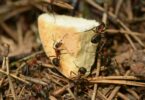Coordination Chemistry Multiple Choice Questions:
Ques. In [NiCl4]2–, the number of unpaired electron is
(a) 4.5
(b) 2
(c) 3
(d) 4
Ques. How many ions are produced in aqueous solution of [Co(H2O)6]Cl2
(a) 2
(b) 6
(c) 4
(d) 3
Ques. AgCl precipitate dissolves in ammonia due to the formation of
(a) [Ag(NH4)2]OH
(b) [Ag(NH4)2]Cl
(c) [Ag(NH3)2]OH
(d) [Ag(NH3)2]Cl
Ques. Which of the following is non-ionizable?
(a) [Co(NH3)3Cl3]
(b) [Co(NH3)4 Cl2]Cl
(c) [Co(NH3)5 Cl]Cl2
(d) [Co(NH3)6]Cl2
Related: the central nervous system quiz
Ques. The oxidation number of cobalt in K[Co(CO)4] is
(a) +1
(b) –1
(c) +3
(d) –3
Ques. The complex salt can be made by the combination of [CoIII(NH3)5 Cl]x with:
(a) Na+
(b) Cl–
(c) 2Cl–
(d) 2K+
Ques. The co-ordination number of copper in cuprammonium sulphate is
(a) 2
(b) 6
(c) 4
(d) – 4
Ques. Which one of the following is an inner orbital complex as well as diamagnetic in behaviour (Atomic number : Zn = 30), Cr = 24, Co = 27, Ni = 28)
(a) [Zn(NH3)6]2+
(b) [Cr(NH3)6]3+
(c) [Co(NH3)6]3+
(d) [Ni(NH3)6]2+
Related: Ionic Equilibrium question bank
Ques. IUPAC name of [Co(NH3)5NO2]Cl2
(a) Pentamminenitrocobalt (III) chloride
(b) Pentamminenitrocobalt (II) chloride
(c) Pentamminenitrosocobalt (III) chloride
(d) None of these
Ques. The oxidation state of Fe in K4[Fe(CN)6] is
(a) +2
(b) –2
(c) +3
(d) +4
Ques. The number of unpaired electrons in the complex ion [CoF6]3–is (Atomic no. of Co = 27)
(a) 2
(b) 3
(c) 4
(d) Zero
Ques. The complex compounds which result from the coordination of carbon monoxide are known as
(a) Electronic
(b) Carbonyls
(c) Carbonates
(d) Carbon permono
Related: Photoelectric effect test questions
Ques. The type of isomerism present in nitropentamine chromium (III) chloride is
(a) Linkage
(b) Optical
(c) Ionization
(d) Polymerisation
Ques. What is the use of tetraethyl lead?
(a) As a catalyst in addition reaction of alkenes
(b) As a catalyst in polymerization reaction of alkenes
(c) For reducing knocking
(d) For creating knocking
Ques. Which is the example of hexadentate ligand?
(a) Dimethyl glyoxime
(b) Ethylene diammine tetra acetate ion [EDTA]
(c) Aminodiacetate ion
(d) 2, 2—dipyridyl
Ques. The neutral ligand is
(a) Chloro
(b) Hydroxo
(c) Ammine
(d) Oxalato
Related: Biomolecules: MCQs Quiz
Ques. The number of neutral molecules or negative groups attached to the central metal atom in a complex ion is called
(a) Primary valency
(b) Coordination number
(c) Effective atomic number
(d) Atomic number
Ques. d2sp3 hybridisation leads to
(a) Hexagonal shape
(b) Octahedral shape
(c) Tetrahedral shape
(d) Trigonal bipyrimidal
Ques. The IUPAC name of [Ni(CO)4] is
(a) Tetra carbonyl nickel (II)
(b) Tetra carbonyl nickel (0)
(c) Tetra carbonyl nickelate (II)
(d) Tetra carbonyl nickelate (0)
Ques. Cuprammonium ion [Cu(NH3)4]2+ is
(a) Square planar
(b) Tetrahedral
(c) Triangular bipyramid
(d) Octahedral
Related: Questions on purification of organic compounds
Ques. What is the EAN of nickel in Ni(CO)4?
(a) 34
(b) 35
(c) 32
(d) 36
Ques. Change in composition of co-ordination sphere yields which types of isomers
(a) Optical
(b) Geometrical
(c) Ionisation
(d) None of these
Ques. Which one of the following complexes is paramagnetic?
(a) [Co(F)6]3+
(b) [Co(H2O)6]3+
(c) [CoF3(H2O)3]
(d) All of these
Ques. The oxidation state of Fe in the complex [Fe(CO)5] is
(a) –1
(b) +2
(c) +4
(d) Zero
Related: Objective Questions on Solid State Chemistry
Ques. Grignard reagent is a
(a) Coordinate compound
(b) Double salt
(c) Organometallic compound
(d) None of these
Ques. pi-bonding is not present in
(a) Grignard reagent
(b) Dibenzene chromium
(c) Zeise’s salt
(d) Ferrocene
Ques. The complex [Pt(NH3)6]Cl4 furnishes
(a) 4 ions
(b) 5 ions
(c) 3 ions
(d) 2 ions







This is very helpful
This is very helpful keep it up
Really great question ⁉️
Chemistry
Good
Answer therichikala two times answers panna mam
Very nice thanks